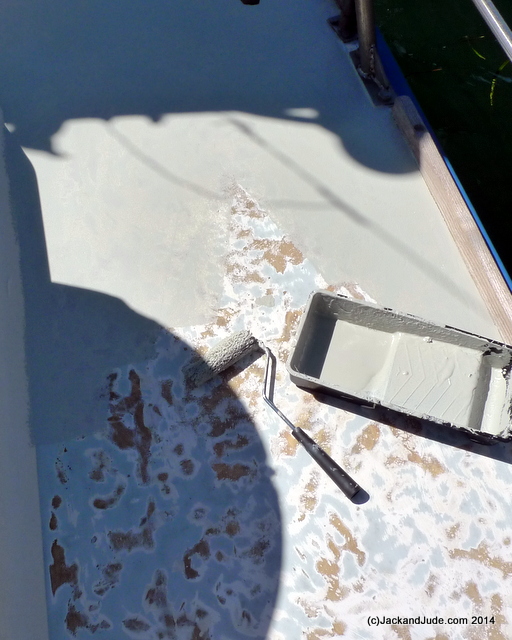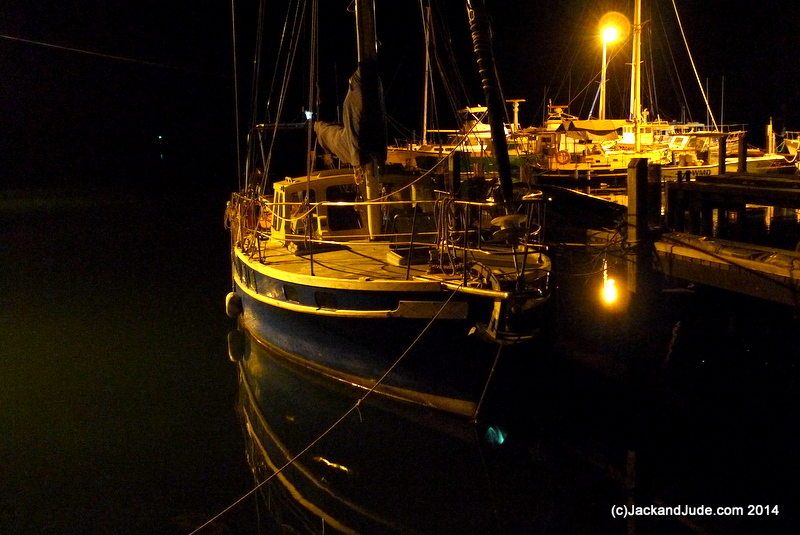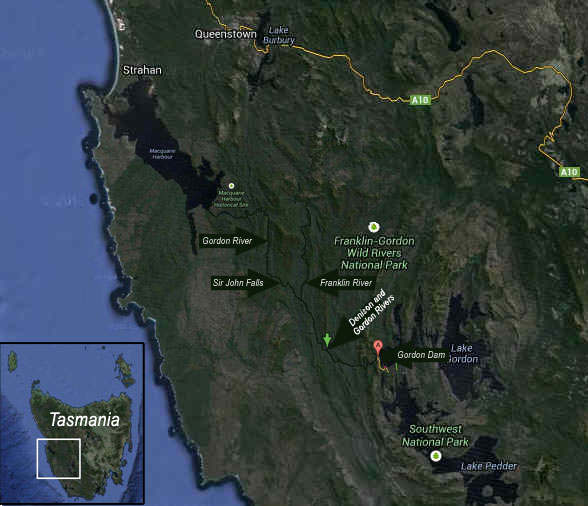Blog of Jack and Jude
explorers, photographers, authors
March 2014 February 2014>>
See where we’re living –
Take a flight around Oyster Harbour
On my morning walk a few weeks ago, I came across a fellow flying one of those quad-copters, a rather scaled down version of a spy drone. And he had a GoPro camera attached. So I invited him back to our boat where over a coffee we watched his footage. Amazing stuff! So good I talked Dave into coming back the next morning for a quick fly around tour of Oyster Harbour. Take a look at where we’re living >
PAINTING UPDATE:
It’s going really well. A perfect day saw the first primer go on smoothly, sticking really well. And this morning, now that two rainy days have fled past, we rolled on a second primer coat, also looking super. Jude’s delighted. The coatings passed her thumbnail test for adhesion. In the next three days we hope to apply three top-coats, anti-skid added to the first coat.
We are using:
HEMPEL’S UNI-PRIMER 13140™
HEMPALIN ENAMEL 52140™ Topcoat
What went on – now comes off
We have learned a lot about deck coatings these last few weeks. The experts tell us that even though an anti-skid surface is rough, it is one of the hardest surfaces for new paint to stick to because it is so hard to abrade. One professional yacht painter told us he always grinds off old deck coatings, and that’s what we have been doing!
This work episode began when our yacht began shedding sheets of the coatings we put on in Port Lincoln about three years ago. We thought a good scrub would have guaranteed a good coating, but we were wrong, although the choice of paints also seems to be a factor. The Berger Jet Dry we used over the existing enamel gave about a year’s good service before patches began to lift. In three years, a lot had bubbled.
Here alongside Emu Point Slipway in Albany, we jet blasted our deck, but some bits continued to stick, meaning we had several different coatings exposed. The local paint store sold us their recommended product for use on a yacht’s deck in that condition, but then that weekend we discovered upon reading the can that the paint maker strongly recommends not putting their paint on surfaces exposed to a salt environment. The White Knight paint techs wrote to us that their oil based paving paint breaks down quickly when exposed to salt. That put a whole new game into play.
One of our boatie friends, an advocate of the new acrylics strongly suggested using the locally produced Phoenix Paints. But getting useful information from them proved rather a chore as it seems our 20 m2 is small potatoes for them. They didn’t have any suggestion as to where we could see their stuff and instead quoted their EasyTread system incorporating rubber granules at just over $500 sans delivery. Following a parallel course, a local marine store recommended Hempel paints, who gave us great service. Their techs wrote volumes on the best way to produce a long lasting anti-skid deck, and quoted a system based on their commercial vessel enamel coatings, with appropriate primer, at half the others price, delivered.
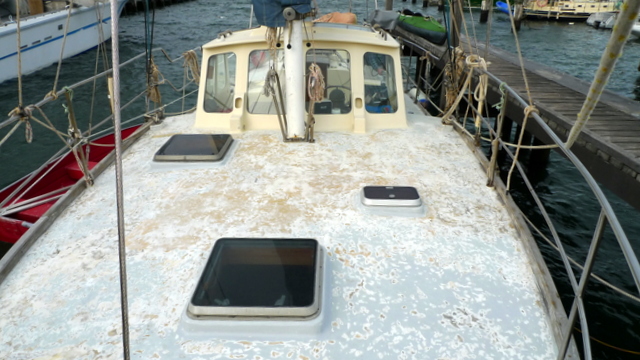
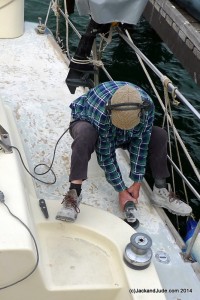
We have decided to give the new system the best chance of success by getting rid of the last bits of acrylic paving paint.
Our paint has arrived and one more day of grinding will see our decks ready. Alas, the weather forecasts are for continued showers off and on through next week.
Watch this space. Hopefully we’ll be ready to recommence our sail around Australia the first week in April.
Alongside Emu Point Slipway’s travel hoist. We have jet-blasted our decks, patched and we’re prepared for coatings. A few showers over the next days will hamper our finishing the job. All’s good. Preparations proceeding nicely, along with having a good time socially.
Home and Straight to Work
After six weeks away, climbing aboard our floating home again became an obsession. On the long flight across the Australian continent to Perth then again on the long bus journey to reach Albany, our thoughts constantly wandered to how we’d find our ship. She’d been left quite alone on a mooring in the middle of Oyster Harbour, admittedly one of the south coast’s safest harbours.
From shore, Banyandah looked upright and on her lines, and we both uttered a sigh of relief. Then after piling our rucksacks and other gear into Little Red, Jack heaved on the oars while I kept my eyes straight ahead on our treasure. Little did we suspect that although everything looked fine, our lady had indeed suffered a mishap.
Upon reaching our ship, both of us were alarmed to see a robust skirt of barnacles extending from around her waterline. But that was soon forgotten in the hubbub of checking our ship and putting our clobber away after finding her in good order.
It wasn’t until later that evening when down below, instead of the quiet tinkling of sea along our ship, we heard what sounded like breaking surf from the wind blown sea rustling up and down upon our new extended breakwater.
This proved disastrous the next day when we tried to move our lady. Even though Jack had tested the engine’s propulsion, after letting go the mooring line, he discovered that we had little if any forward motion. “I’ve got no steerage,” he yelped. Seems our ship only went to the right, and then only very slowly. Thankfully, with our engine roaring, Jack was able to go in a circle to retrieve the mooring.
Then, suited up, mask and flippers on, a scraper in hand, he dove over the side, and instead of our propeller, he saw a huge ball of shells. Well Jack’s not as young as he once was, and surfaced gasping for air. His mask had fogged up. His hands bled from numerous cuts, but down he went, again, and again. I couldn’t watch. Each time he came up he sounded more like a man about to have a heart attack, so I stay out of sight, working out what I’d do if his heart suddenly gave up. Which it never did, even though his gasping and wheezing sounded like a old racehorse stretching for the finish.
Of course we got our lady cleaned up, and then moved her to a mooring under the pretty green slopes of Mount Martin botanical garden, where we are presently catching up on our logs, enjoying a morning paddle, and completing our preps for repainting our decks.
Our plans, loose may they be, are to start sailing east in about 10 days or maybe 2 weeks.
The last few days before flying from the east coast, we went camping in the Border Ranges National Park, which is centered around the southern hemisphere’s largest caldera at Mount Warning. Here are just a few photos of that amazing place. Click any image to bring up the viewer.
[pe2-gallery album=”http://picasaweb.google.com/data/feed/base/user/104116039572666292815/albumid/5986863441660910801?alt=rss&hl=en_US&kind=photo” ]
Our website has undergone a major facelift
Since created a few years ago, our website has been fixed at 940 pixels width. Now it’s responsive, meaning it should re-size according to screen width – So it should fit handheld devices and all other screens displaying up to its max width of 1280 pixels. A major revamped was required to achieve this, including theme change, new plugins and images. Contact us if you notice any display problems, thanks.
Short Timers
Jack has been working for more than a week to achieve the website upgrade and he’s pretty full up on web work. Especially as the far horizon keeps beckoning him to set sail, and that just what the Tujays, Jack and Jude, will be doing very shorty. We fly back across the country in a week’s time. Only seven big sleeps till we’re back on board Banyandah. While Jack’s been locked to his computer, Jude has been manning Jerome’s computer shop because he went off racing in the Hobie 16 Worlds held in Jervis Bay. Jerome did fantastically well to make it through the 10 qualifying races and into the finals. The competition was intense. Unfortunately His crew Deb tore off a toe nail on the first day of the finals and had to be carried off the beach. Jerome grabbed a 15 year old kid off the beach and continued racing. Together they finished mid fleet overall, but scored an amazing 11th in the second last race. They all came home battered and bruised holding a trophy.
First chore once back on board will be repainting our decks. The anti-skid paint we applied a few years ago in Port Lincoln didn’t stick so well. It seems we should have used a primer – even though the paint maker said none was needed. Don’t believe everything you read. A lesson relearned after many hours of scraping and jet blasting off the flaky acrylic paint.
After that we’re heading east, first to Esperance then the Recherche Archipelago and onwards, investigating all the little out of the way spots to South Australia. Watch this space.
Film Making on the Gordon River
(click on any image to enlarge)
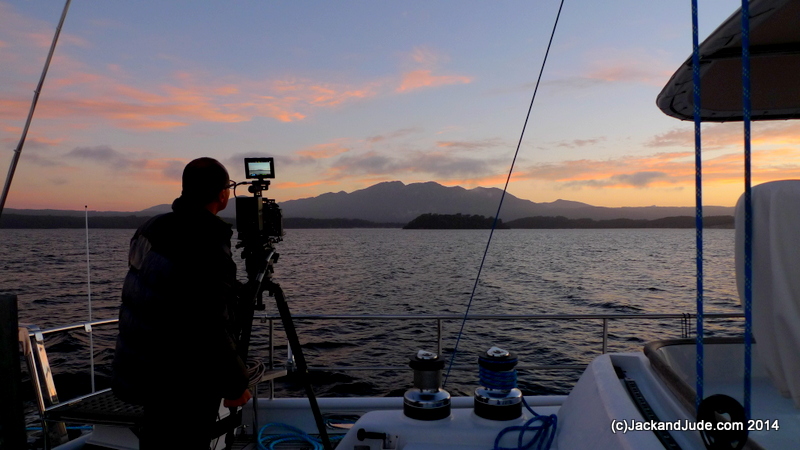 Sometimes an adventure can become a disaster when bad weather, people friction, or bad decisions prevail. Other times, an adventure can flow from one high to an even greater one when the team merges to successfully overcome every adversity, especially when the adventure is blessed with perfect conditions. Happily this is about one of those events.
Sometimes an adventure can become a disaster when bad weather, people friction, or bad decisions prevail. Other times, an adventure can flow from one high to an even greater one when the team merges to successfully overcome every adversity, especially when the adventure is blessed with perfect conditions. Happily this is about one of those events.
From the early 1900s, the Morrison family of Strahan were actively involved in harvesting the unique timbers found around Macquarie Harbour located on the west coast of Tasmania. Today there are but a few in this family working in an industry that has been greatly altered by the passage of time. What was once harvested and then used extensively in shipbuilding and furniture making is now protected. On the shores of downtown Strahan, Grant Morrison, known locally as Snowy, runs the family sawmill producing Huon, Celery Top, and King Billy Pine products for the craft and tourist industries. Snowy’s cousin, Ronnie Morrison, a local identity known best for his development of the local salmon fish farm industry, worked as a young man alongside his father Keith and uncle Reg, deep in what is today the world heritage forests surrounding Macquarie Harbour. Many years might have passed, but Ronnie Morrison retains crisp memories of his time swinging an axe and cranking a Wallaby jack, and it was with Ronnie as team leader that we ventured into wild country seen by few in the modern era.
The purpose of this venture – to document the history of an era fast slipping away and becoming a dim memory. The storyline – an experienced bushman shows a newcomer the old ways of harvesting the ancient Pines found in Tasmania’s southwest. Our team consisted of the award winning cinematographer Joe Shemesh and his sound technician Sarah; the principal actors, Ronnie Morrison and Franz Docherty; the producer/director Garry Kerr; with Ronnie Morrison’s son Deek and Jude and Jack as support crew.
[ READ MORE ]
Post Script – 5 Feb:
We are home and surrounded by a swarm of grandchildren and loving it. Ballina is green, wet, and everything seems to be in order here – house still standing, car runs smoothly, kids are well and going great guns.
Our journey out of Strahan was long and arduous. A whole day on a bus winding around every bend in Tasmania hyped us up and wore us down to such a level that our friend in Launceston had to pour a whole bottle of champagne down us before we began to settle. Which better said is we finished three champagnes one after another then embarked on an evening of funny stories, fine food, and many frank and revealing recollections. Starting early next morn, two air flights with a long wait in dreary Sydney saw us safely into our family’s arms, all’s well that ends well.
Jude’s knee performed wonderfully well on our treks into Tasmania’s rainforest while filming the documentary. In fact she is better on uneven ground than flat pavement. We had trekked rocky creeks, along wallaby tracks, up slopes, and used saplings to hoist ourselves up onto ledges. Her Pro-Orthopedics knee brace did a magnificent job.
Jude worked very hard provisioning the ship for the eight on board, and provided a yummy lunch everyday that we went off to shoot scenes way up into the upper reaches of the Gordon River. Our latest blog has a map showing how far up we got, and there’s a link at its end to another big swag of photos. Might whet your appetite to do a rafting trip down the Franklin to the Gordon, or as I suggested in my blog, to trek the historical track cut for Sir John Franklin in 1842 that we helped clear last year.

